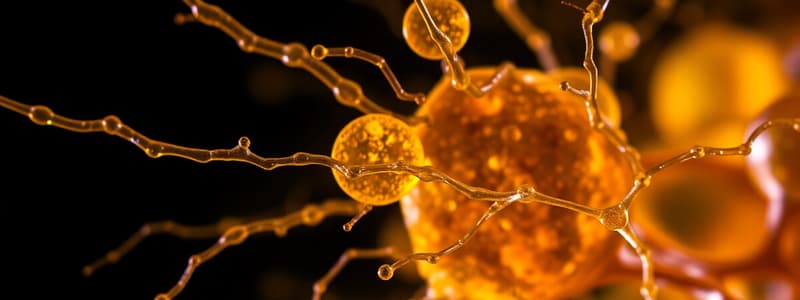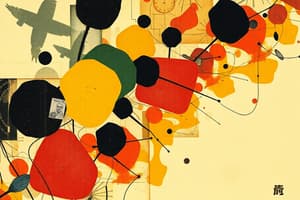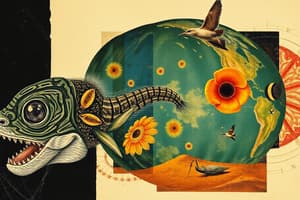Podcast
Questions and Answers
Which of the following pigments enters the body primarily through food?
Which of the following pigments enters the body primarily through food?
- Melanin
- Carotenoid (correct)
- Hemoglobin
- Lipofuscin
Which endogenous pigment is a product of hemoglobin breakdown?
Which endogenous pigment is a product of hemoglobin breakdown?
- Melanin
- Carotenoid
- Hemosiderin (correct)
- Lipofuscin
Which of these structures is categorized as part of the cytoskeleton?
Which of these structures is categorized as part of the cytoskeleton?
- Mitochondria
- Ribosomes
- Microtubules (correct)
- Centrosomes
Which organ is known to store the highest amounts of glycogen?
Which organ is known to store the highest amounts of glycogen?
Which of the following is classified as an exogenous pigment?
Which of the following is classified as an exogenous pigment?
What is the primary function of microtubules in a cell?
What is the primary function of microtubules in a cell?
Which characteristic distinguishes microfilaments from other cytoskeletal components?
Which characteristic distinguishes microfilaments from other cytoskeletal components?
What type of cytoplasmic inclusions are primarily responsible for energy storage in animal cells?
What type of cytoplasmic inclusions are primarily responsible for energy storage in animal cells?
Which statement about intermediate filaments is accurate?
Which statement about intermediate filaments is accurate?
How can glycogen be detected in cells using microscopy?
How can glycogen be detected in cells using microscopy?
What are exogenous pigments?
What are exogenous pigments?
Which type of cytoplasmic inclusion is NOT typically involved in cellular functions?
Which type of cytoplasmic inclusion is NOT typically involved in cellular functions?
What role do basal bodies play in relation to microtubules?
What role do basal bodies play in relation to microtubules?
Which component is responsible for the formation of secretory proteins?
Which component is responsible for the formation of secretory proteins?
What is the primary structural component of ribosomes?
What is the primary structural component of ribosomes?
What are the two cylindrical rodlets found in a centrosome called?
What are the two cylindrical rodlets found in a centrosome called?
Which structure plays a significant role in maintaining cell shape?
Which structure plays a significant role in maintaining cell shape?
What is the size range of ribosomes?
What is the size range of ribosomes?
Which type of filament is part of the cytoskeleton responsible for cell motility?
Which type of filament is part of the cytoskeleton responsible for cell motility?
How are centrioles structurally composed?
How are centrioles structurally composed?
What role does the centrosome serve during cell division?
What role does the centrosome serve during cell division?
Flashcards
Exogenous pigments
Exogenous pigments
Pigments that enter the body from outside sources, primarily through food.
Endogenous pigments
Endogenous pigments
Pigments produced within the body.
Hemoglobin
Hemoglobin
A vital pigment; gives blood its red color and is essential for respiration.
Ribosomes
Ribosomes
Signup and view all the flashcards
Melanin
Melanin
Signup and view all the flashcards
Microtubules
Microtubules
Signup and view all the flashcards
Microfilaments
Microfilaments
Signup and view all the flashcards
Intermediate Filaments
Intermediate Filaments
Signup and view all the flashcards
Cytoplasmic Inclusions
Cytoplasmic Inclusions
Signup and view all the flashcards
Stored food (inclusions)
Stored food (inclusions)
Signup and view all the flashcards
Exogenous Pigments
Exogenous Pigments
Signup and view all the flashcards
Endogenous Pigments
Endogenous Pigments
Signup and view all the flashcards
Cell Shape
Cell Shape
Signup and view all the flashcards
Ribosomes
Ribosomes
Signup and view all the flashcards
Attached Ribosomes
Attached Ribosomes
Signup and view all the flashcards
Free Ribosomes
Free Ribosomes
Signup and view all the flashcards
Centrosome
Centrosome
Signup and view all the flashcards
Centrioles
Centrioles
Signup and view all the flashcards
Cytoskeleton
Cytoskeleton
Signup and view all the flashcards
Microtubules
Microtubules
Signup and view all the flashcards
Cell Organelles
Cell Organelles
Signup and view all the flashcards




